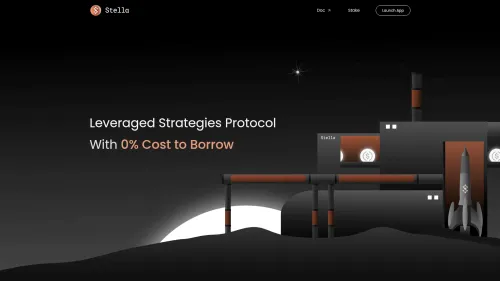Stella (ALPHA)
Stella is a leveraged strategies protocol characterized by a 0% borrowing cost. It enables borrowers, called "leveragoors," to engage in supported decentralized finance (DeFi) strategies without incurring borrowing costs. This system allows lenders to earn a yield from borrowers through a lending annual percentage yield (APY). Stella's "Pay-As-You-Earn" (PAYE) model is designed to ensure that the success of borrowers directly enhances the earnings for lenders, maximizing yield potential for both parties.
Overview of Stella
Stella operates on the Pay-As-You-Earn Model (PAYE), emphasizing yield sharing between lenders and borrowers. The protocol consists of two main components: Stella Strategy and Stella Lend.
Pay-As-You-Earn (PAYE) Model
In Stella's PAYE model, borrowers do not incur borrowing costs unless they generate yields. The model allocates a portion of these yields to be shared with lenders, enhancing capital efficiency. This approach fosters a mutual incentive alignment between borrowers and lenders.

| Ticker | ALPHA |
| Category | Decentralized Finance (DeFi) |
| Website | https://stellaxyz.io/ |
| @stellaxyz_ | |
| Telegram | Stellaxyz_io |
| Contract Addresses | |
|---|---|
| ethereum | 0xa1...75 Copied! Copied! |
| avalanche | 0x21...8f Copied! Copied! |
| energi | 0x05...17 Copied! Copied! |
| binance-smart-chain | 0xa1...75 Copied! Copied! |
Stella Strategy
Borrowers can leverage various strategies integrated with different DeFi protocols. Instead of paying interest, borrowers share the yield earned upon closing a position. Stella's latest upgrade, Hypernova, introduces two strategy types: Hyper and Standard.
Hyper Strategy
The Hyper Strategy allows users to access high-yield strategies, such as the Leveraged Pendle LP Strategy on Liquid Staking Tokens (LSTs), potentially earning up to 30% on leveraged positions.
Standard Strategy
The Standard Strategy focuses on well-established decentralized exchanges (DEXes) like UniV3 and Trader Joe, involving major assets like ETH, BTC, USDT, and USDC.
Asset types
Stella Strategy categorizes underlying assets into three types based on market factors: stable assets, major assets, and volatile assets. Each type offers different risk and return profiles.
Strategy exposure
Borrowers can choose from long, short, or neutral strategies based on their market expectations.
Long Strategy
A Long Strategy is employed when borrowers anticipate an asset's price increase.
Short Strategy
A Short Strategy is used when borrowers expect a price decrease in an asset.
Neutral Strategy
The Neutral Strategy involves maintaining equal levels of long and short exposure when asset prices are expected to remain stable.
Collateral factor and borrow factor
Stella uses the liquidity provider (LP) concept as collateral for loans, assigning collateral and borrow factors based on asset volatility and other considerations.
Stella Lend
Lenders contribute assets to Stella's lending pools to earn yields, shared from Stella's Strategy. The lending APY is based on borrower-shared yields, with no maximum cap.
Yield vault
Shared yields from borrowers are accumulated in an intermediate vault before being distributed to lenders, ensuring a consistent yield flow.
ALPHA Token
The ALPHA token is Stella’s official token, with a portion of borrower yields collected as protocol fees.
Staking
ALPHA token holders can stake their tokens to support Stella's security, receiving benefits such as protocol fees, yield sharing, access to incubated project tokens, and voting rights in governance.
Token distribution
The total supply of ALPHA tokens is 1,000,000,000, allocated across various channels, including Binance Launchpad, private sales, liquidity mining, team and advisors, and the ecosystem.
